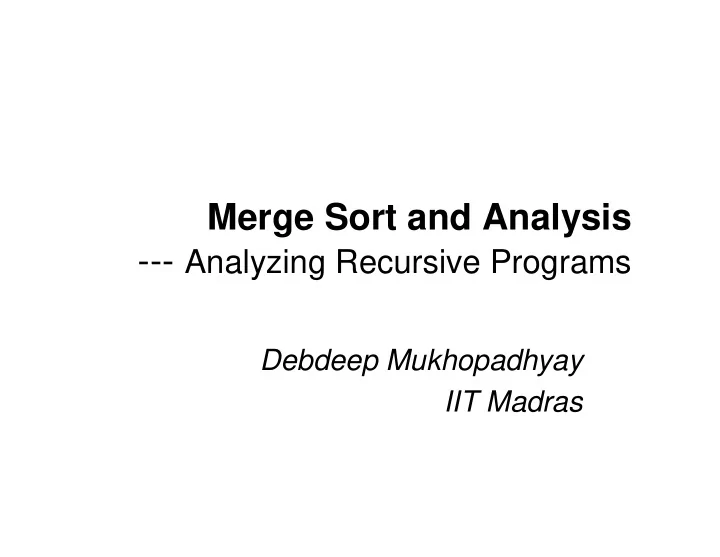

Merge Sort and Analysis --- Analyzing Recursive Programs Debdeep Mukhopadhyay IIT Madras
Why are we dealing with merge sort in this course? • It is a powerful application of Divide and Conquer technique in problem solving • Also radically different from insertion, selection and bubble sort. • We can now apply the techniques and compare the performance of this sort with the previous ones
Merging • Produce a sorted list from two sorted lists • A simple way is to examine from the front. • At each step find the smaller of the two elements at the current fronts • Choose that element as the next element of the merged list. • Remove the chosen element from its list, exposing the next element as the now first element.
Example of Merging Iteratively L1 L2 M 1,2,7,7,9 2,4,7,8 Empty 2,7,7,9 2,4,7,8 1 7,7,9 2,4,7,8 1,2 7,7,9 4,7,8 1,2,2 7,7,9 7,8 1,2,2,4 7,9 7,8 1,2,2,4,7 9 7,8 1,2,2,4,7,7 9 8 1,2,2,4,7,7,7 9 Empty 1,2,2,4,7,7,7,8 Empty Empty 1,2,2,4,7,7,7,8,9
Implementation of Merge Sort (MS) • It is easier to conceive in terms of a Linked List (LL) • We have seen LLs in the lab. • It is represented by a node (cell), which has two components: one info and the other pointer to the next element. struct node{ int info; Definition of the struct node *next; nodes in C }; typedef struct node *NODEPTR;
Inserting elements into the LL #include<malloc.h> NODEPTR getnode() { NODEPTR p; p=(NODEPTR)malloc(sizeof(NODEPTR)); return(p); } void insert(NODEPTR p,int val) { NODEPTR q; p->next p q=getnode(); q->info=val; q->next=p->next; p->next=q; q->next q va l }
Traversing the LL void print(NODEPTR p) { NODEPTR q; for(q=p->next;q!=NULL;q=q->next) { printf("%d \t",q->info); } }
Merging NODEPTR merge(NODEPTR list1, NODEPTR list2) { if(list1==NULL) return(list2); else if(list2==NULL) return(list1); else if(list1->info<=list2->info){ list1->next=merge(list1->next,list2); return(list1); } else{ list2->next=merge(list1,list2->next); return(list2); } }
Pictorial Description return To merged list � value list1 list2 Merged In Recursive call • Dotted line represents initial list. After the recursive calls merge create the solid lines.
Recursive calls to merge Call Return merge(12779,2478) 1 22477789 merge(2779,2478) 2 2477789 merge(779,2478) 2 477789 merge(779,478) 4 77789 merge(779,78) 7 7789 merge(79,78) 7 789 merge(9,78) 7 89 merge(9,8) 8 9 merge(9,NULL) 9
Splitting the list into 2 equal parts NODEPTR split(NODEPTR list) { NODEPTR pSecondCell; if(list==NULL) return(NULL); else if(list->next==NULL) return(NULL); else{//list contains more than two elements pSecondCell=list->next; list->next=pSecondCell->next; pSecondCell->next=split(pSecondCell->next); return(pSecondCell); } }
Pictorial representation of split pSecondCell Recursive call to split
The sorting algorithm NODEPTR MergeSort(NODEPTR list) { NODEPTR SecondList; NODEPTR printlist; static int i=0; i=i+1; printlist=getnode(); printlist->next=list; printf("\n Rec No %d: The curr list is \n",i); print(printlist); if(list==NULL) return(NULL); else if(list->next==NULL) return(list); else{//at least two elements on list SecondList=split(list); return(merge(MergeSort(list),MergeSort(SecondList))); } }
Snap of the main NODEPTR list; list=getnode(); list->next=NULL; while(val!=-1) { scanf("%d",&val); insert(list,val); } printf("The entered list is:\n"); print(list); list->next=MergeSort(list->next); printf("\nThe sorted list is:\n"); print(list); }
Splitting and Merging Recursively 742897721 122477789 2478 72971 4872 12779 791 27 47 82 179 27 47 28 2 71 9 2 7 4 7 8 2 17 9 2 7 4 7 8 7 1 7 1
Analyze the merge function NODEPTR merge(NODEPTR list1, NODEPTR list2) { if(list1==NULL) return(list2); O(1)+O(1) else if(list2==NULL) return(list1); O(1)+O(1) else if(list1->info<=list2->info){ O(1) list1->next=merge(list1->next,list2); O(1)+T(n-1) return(list1); O(1) } else{ list2->next=merge(list1,list2->next); O(1)+T(n-1) return(list2); O(1) } } n is the input size of the problem; n is the sum of the two lists which are merged T(1)=O(1),T(n)=O(1)+T(n-1)
RR for merge • T(n)=T(n-1)+O(1) => T(n)=O(n) • This is a 1-LiNoReCoCo • CE has roots, r=1with multiplicity 1. • F(n)=O(1). Thus the particular solution is P(n)=n(C) • Thus T(n)=C 1 +nC=O(n)
Analyze the split NODEPTR split(NODEPTR list) { NODEPTR pSecondCell; if(list==NULL) return(NULL); O(1) else if(list->next==NULL) return(NULL); O(1)+O(1) else{//list contains more than two elements pSecondCell=list->next; O(1) list->next=pSecondCell->next; O(1) pSecondCell->next=split(pSecondCell->next); O(1)+T(n-2) return(pSecondCell); O(1) } } n is the length of the list which is being split T(0)=T(1)=O(1); T(n)=T(n-2)+O(1)=> T(n)=O(n)
Analyzing merge sort NODEPTR MergeSort(NODEPTR list) { if(list==NULL) return(NULL); O(1) else if(list->next==NULL) return(list); O(1) else{//at least two elements on list SecondList=split(list); O(1)+O(n) return(merge(MergeSort(list),MergeSort(SecondList))); 2T(n/2)+O(n) } } n is the number of elements in the list T(1)=O(1);T(n)=2T(n/2)+O(n)
Solve the RR • T(n)=2T(n/2)+O(n) • By Master’s Theorem, a=2, b=2, d=1 • We have log 2 2=1 • So, we have T(n)=O(nlogn) • Thus we have a better sorting algorithm in the worst case than the previous sorting algorithms we have seen. • In fact we have T(n)= Θ (nlogn)
Further Discussions • We have also discussed on a Divide and Conquer strategy to solve the closest pair problem of n Cartesian points, better than the straight forward O(n 2 ) algorithm • Recurrence relation was: – T(n)=2T(n/2)+7n which leads to T(n)=O(nlogn)
Recommend
More recommend